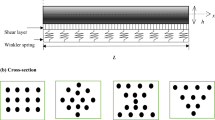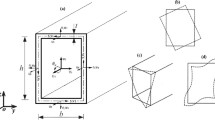Abstract
This study proposes a type of trabecular–honeycomb biomimetic structures with high-efficiency energy-absorbing abilities inspired by beetle elytra. Because the trabecular structure is distributed at the ends of the honeycomb walls, the proposed structure is named an end-trabecular beetle elytron plate crash box, or EBEP crash box for simplification. A comparison between the EBEP crash box and conventional crash box (a buffering structure generally used in modern devices and vehicles) is conducted using compression experiments and finite element method. We present the following results. (1) In contrast to the fluctuation stage with a low force in a conventional crash box, the force–displacement curve of the EBEP crash box possesses a rising stage and an approximate plateau with a higher force; as a result, the absorbing energy ability and compression force efficiency are 5 and 2.6 times greater than those of a conventional crash box, respectively. (2) Experimental and numerical comparisons reveal that there is cracking failure in the conventional crash box; however, the coordinated and uniform S-typed laminated compression deformation is developed in the EBEP crash box. (3) The influences of the amplitude (A) of the sine wave deformation line on the peak force and the compression force efficiency of the EBEP crash box are investigated, thereby providing a feasible method for adjusting the peak force according to different engineering requirements. These results provide new inspiration for applying EBEP crash boxes and exploiting new buffering structures and materials in the energy-absorbing field.








Similar content being viewed by others
References
Liu Z, Hao W, Xie J, Lu J, Huang R, Wang Z (2015) Axial-impact buckling modes and energy absorption properties of thin-walled corrugated tubes with sinusoidal patterns. Thin-Walled Struct 94:410–423
Yi L, Chang T, Feng XQ, Zhang Y, Wang J, Huang B (2017) Giant energy absorption capacity of graphene-based carbon honeycombs. Carbon 118:348–357
Tao Y, Duan S, Wen W, Pei Y, Fang D (2017) Enhanced out-of-plane crushing strength and energy absorption of in-plane graded honeycombs. Compos Part B Eng 118:33–40
Ying L, Zhao X, Dai M, Zhang S, Hu P (2016) Crashworthiness design of quenched boron steel thin-walled structures with functionally graded strength. Int J Impact Eng 95:72–88
Reuter C, Tröster T (2017) Crashworthiness and numerical simulation of hybrid aluminium-CFRP tubes under axial impact. Thin-Walled Struct 117:1–9
Isaac CW, Oluwole O (2016) Energy absorption improvement of circular tubes with externally press-fitted ring around tube surface subjected under axial and oblique impact loading. Thin-Walled Struct 109:352–366
Bates SRG, Farrow IR, Trask RS (2016) 3D printed polyurethane honeycombs for repeated tailored energy absorption. Mater Des 112:172–183
Qiu N, Gao Y, Fang J, Feng Z, Sun G, Li Q (2016) Theoretical prediction and optimization of multi-cell hexagonal tubes under axial crashing. Thin-Walled Struct 102:111–121
Sun F, Lai C, Fan H (2016) In-plane compression behavior and energy absorption of hierarchical triangular lattice structures. Mater Des 100:280–290
Jin X, Jin T, Su B, Wang Z, Ning J, Shu X (2017) Ballistic resistance and energy absorption of honeycomb structures filled with reactive powder concrete prisms. J Sandw Struct Mater 19:544–571
Imbalzano G, Tran P, Ngo TD, Lee PVS (2017) Three-dimensional modelling of auxetic sandwich panels for localised impact resistance. J Sandwich Struct Mater 19(3):291–316
Imbalzano G, Tran P, Ngo TD, Lee PVS (2016) A numerical study of auxetic composite panels under blast loadings. Compos Struct 135:339–352
Chen Y, Li T, Jia Z, Scarpa F, Yao CW, Wang L (2017) 3d printed hierarchical honeycombs with shape integrity under large compressive deformations. Mater Des 137:226–234
Yin H, Huang X, Scarpa F, Wen G, Chen Y, Zhang C (2018) In-plane crashworthiness of bio-inspired hierarchical honeycombs. Compos Struct 192:516–527
Thompson DW (1961) On growth and form. Cambridge University Press, New York
Sun J, Wu W, Liu C, Tong J (2017) Investigating the nanomechanical properties and reversible color change properties of the beetle Dynastes tityus. J Mater Sci 52:6150–6160. https://doi.org/10.1007/s10853-017-0895-y
McKittrick J, Chen PY, Tombolato L, Novitskaya EE, Trim MW, Hirata GA, Olevsky EA, Horstemeyer MF, Meyers MA (2010) Energy absorbent natural materials and bioinspired design strategies: a review. Mater Sci Eng C 30(3):331–342
Tran P, Ngo TD, Mendis P (2014) Bio-inspired composite structures subjected to underwater impulsive loading. Comput Mater Sci 82:134–139
Zou M, Yu Y, Zhang R, Wei C, Wang H (2015) Simulation analysis of energy-absorption properties of thin-wall tube based on horn structure. J Jilin Univ (Eng Technol Ed) 45:1863–1868
Tsang HH, Raza S (2018) Impact energy absorption of bio-inspired tubular sections with structural hierarchy. Compos Struct 195:199–210
Zhang P, To AC (2014) Highly enhanced damping figure of merit in biomimetic hierarchical staggered composites. ASME J Appl Mech 81(5):051015
Bührig-Polaczek A, Fleck C, Speck T, Schüler P, Fischer SF, Caliaro M, Thielen M (2016) Biomimetic cellular metals-using hierarchical structuring for energy absorption. Bioinspiration Biomim 11(4):045002
Linz DM, Hu AW, Sitvarin MI, Tomoyasu Y (2016) Functional value of elytra under various stresses in the red flour beetle, tribolium castaneum. Sci Rep 6:34813
Le TQ, Truong TV, Tran HT, Park SH, Jin HK, Park HC, Byun D (2014) How could beetle’s elytra support their own weight during forward flight? J Bionic Eng 11(4):529–540
Chen JX, Ni QQ (2003) Three dimensional composite structures in the fore-wing of beetles. Acta Mater Compos Sin 20(6):61–66
Guo T, Wang Y (2011) Energy absorbing structures imitating trabecular of beetle cuticles. Eng Mech 28:246–250
Xiang JW, Du JX (2017) Energy absorption characteristics of bio-inspired honeycomb structure under axial impact loading. Mater Sci Eng A Struct Mater Prop Microstruct Process 696:283–289
Xiang JW, Du JX, Li DC, Scarpa F (2017) Numerical analysis of the impact resistance in aluminium alloy bi-tubular thin-walled structures designs inspired by beetle elytra. J Mater Sci 52:13247–13260
Hao P, Du JX (2018) Energy absorption characteristics of bio-inspired honeycomb column thin-walled structure under impact loading. J Mech Behav Biomed Mater 79:301–308
Chen JX, Ni QQ (2006) A sandwich structure with Polygon grating in core layer. CN1278848C
Chen JX, Zu Q, Wu G, Xie J, Tuo W (2015) Review of beetle forewing structures and their biomimetic applications in China: (II) On the three-dimensional structure, modeling and imitation. Mater Sci Eng C 55:620–633
Zhang XM, Liu C, Chen JX, Zhang JD, Gu YY, Zhao Y (2016) The influence mechanism of processing holes on the flexural properties of biomimetic integrated honeycomb plates. Mater Sci Eng C 69(1):798–803
Chen JX, Zhang XM, Okabe Y, Xie J, Xu MY (2018) Beetle elytron plate and the synergistic mechanism of a trabecular-honeycomb core structure. Sci China Technol Sci. https://doi.org/10.1007/s11431-018-9290-1
Chen JX, Zhang XM, Okabe Y, Saito K, Guo Z, Pan LC (2017) The deformation mode and strengthening mechanism of compression in the beetle elytron plate. Mater Des 131:481–486
Zhang XM, Xie J, Chen JX, Okabe Y, Pan LC, Xu MY (2017) The beetle elytron plate: a lightweight, high-strength and buffering functional–structural bionic material. Sci Rep 7:4440
Zhang XM, Chen JX, Okabe Y, Xie J, Zhang ZJ (2017) Compression properties of metal beetle elytron plates and the elementary unit of the trabecular-honeycomb core structure. J Sandw Struct Mater. https://doi.org/10.1177/1099636217722823
Zhang XM, Chen JX, Okabe Y, Zhang PW, Xiong XB, Yu XY (2017) Influence of honeycomb dimensions and forming methods on the compressive properties of beetle elytron plates. J Sandw Struct Mater. https://doi.org/10.1177/1099636217731993
Chen JX, Ni QQ, Endo Y, Iwamoto M (2002) Distribution of trabeculae and elytral surface structures of the horned beetle, allomyrina dichotoma (linné) (Coleoptera: Scarabaeidae). Entomol Sin 9:55–61
Chen JX, Yu XY, Xu MY, Okabe Y, Zhang XM, Tuo WY (2018) The compressive properties and strengthening mechanism of the middle-trabecular beetle elytron plate. J Sandw Struct Mater. https://doi.org/10.1177/1099636218777188
Chen JX, Wu G (2013) Beetle forewings: epitome of the optimal design for lightweight composite materials. Carbohyd Polym 91:659–665
El-Hage H, Mallick PK, Zamani N (2006) A numerical study on the quasi-static axial crush characteristics of square aluminum–composite hybrid tubes. Compos Struct 73(4):505–514
Hooputra H, Gese H, Dell H, Werner H (2004) A comprehensive failure model for crashworthiness simulation of aluminium extrusions. Int J Crashworthiness 9(5):449–464
Zou M, Xu S, Wei C, Wang H, Liu Z (2016) A bionic method for the crashworthiness design of thin-walled structures inspired by bamboo. Thin-Walled Struct 101:222–230
Timoshenko GJ (1961) Theory of elastic stability, 2nd edn. McGraw-Hill, New York
Acknowledgements
The work was supported by the National Natural Science Foundation of China (Grant No. 51875102).
Author information
Authors and Affiliations
Corresponding author
Ethics declarations
Conflict of interest
The authors declare that they have no conflicts of interest.
Rights and permissions
About this article
Cite this article
Yu, X., Pan, L., Chen, J. et al. Experimental and numerical study on the energy absorption abilities of trabecular–honeycomb biomimetic structures inspired by beetle elytra. J Mater Sci 54, 2193–2204 (2019). https://doi.org/10.1007/s10853-018-2958-0
Received:
Accepted:
Published:
Issue Date:
DOI: https://doi.org/10.1007/s10853-018-2958-0




